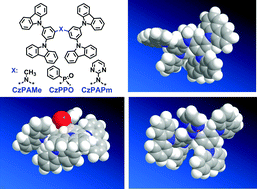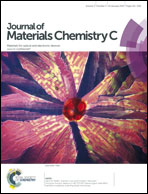Solution-processed bipolar small molecular host materials for single-layer blue phosphorescent organic light-emitting diodes
Abstract
Three new solution processable small molecular host materials based on the bis-[3,5-di(9H-carbazol-9-yl)phenyl] structural moiety have been developed for blue phosphorescent (FIrpic dopant) organic light-emitting diodes. All three host materials have been characterized as having high glass transition temperatures (Tgs), 155–175 °C, indicative of good morphological stability of their amorphous thin films prepared from the solution process. Whereas N,N-bis-[3,5-di(9H-carbazol-9-yl)phenyl]methylamine (CzPAMe) has the highest solid state triplet energy gap (ET) of 2.73 eV, tetrakis-[3,3′,5,5′-(9H-carbazol-9-yl)]triphenylphosphine oxide (CzPPO) and N,N-bis-[3,5-di(9H-carbazol-9-yl)phenyl]pyrimidin-2-amine (CzPAPm) are two host materials which are potentially bipolar for charge transport due to the electron deficient units of phenylphosphine oxide and pyrimidine, respectively. Due to the insufficient ET (2.56 eV) of CzPAPm, CzPPO or CzPAMe devices are significantly better than CzPAPm devices with or without a 1,3-bis[(4-tert-butylphenyl)-1,3,4-oxadiazolyl]phenylene (OXD-7) co-host. Particularly, having no OXD-7 co-host and no vacuum thermal-deposited extra electron transporting layer, single-layer devices of CzPPO surpass CzPAMe devices and reach current efficiencies as high as 9.32 cd A−1 (or power efficiency of 4.97 lm W−1), one of the highest efficiencies among small molecular devices with the same fabrication process and same device configuration.


 Please wait while we load your content...
Please wait while we load your content...